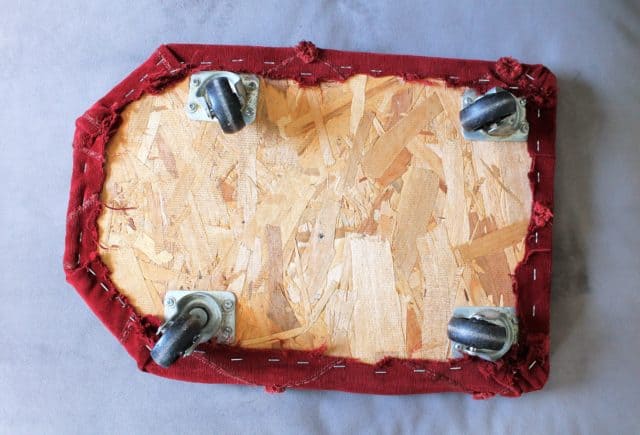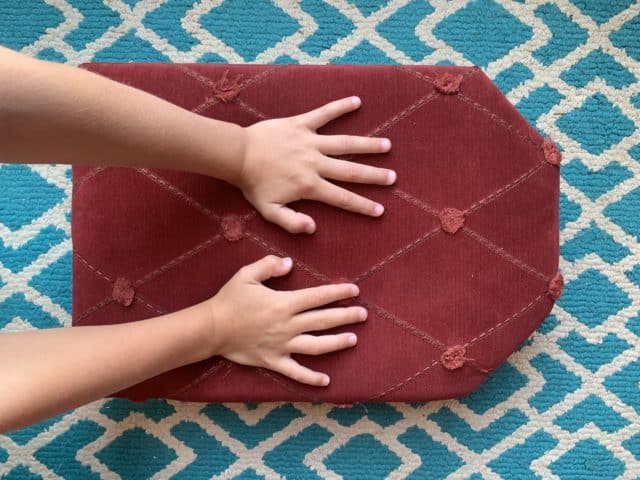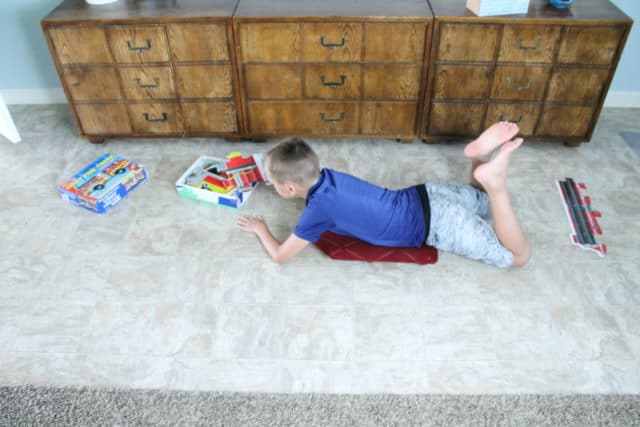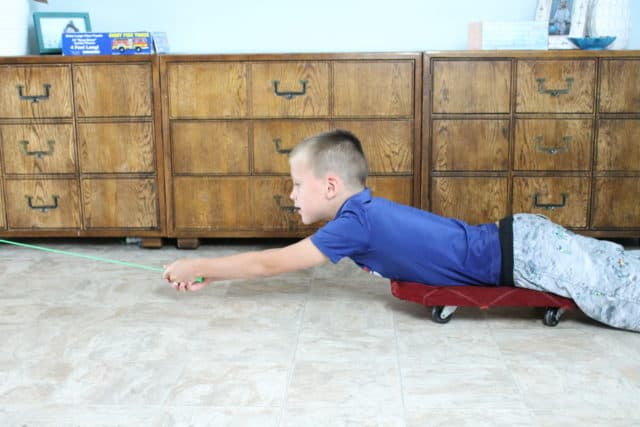Learn how to use a scooter board to help your child with their sensory needs all while having fun! And, find my top picks and how to DIY a scooter board!
Affiliate links used below. See our full disclosure.
If you asked me what my favorite sensory or therapy tools were for kids, the scooter board would be at the top of the list. Not only is the scooter board inexpensive, it takes up a small footprint compared to some other sensory toys, and it’s versatile.
While the focus of this article is on the sensory input and sensations a child gets from using a scooter board, I’ll be telling you 5 of my favorite ways to use it. The scooter board also helps with fine and gross motor skills, as well as core strengthening.
And, kids love it, unless they’re sensitive to movement (aka vestibular input). If that’s the case though, it’s all the more reason to use it, so they can get used to movement and further develop their sensory processing which will help them with countless learning activities!
What is a Scooter Board?
A scooter board is a small rectangle or square with four wheels on the bottom of it. Sort of like a wide skateboard, but the wheels move in all directions. They are popular in elementary and preschool gym classes. Sometimes they have handles or a cushion on top too!
Why Scooter Boards Are So Freakin’ Awesome for Sensory…
Primarily, scooter boards give kids tons of vestibular input, and most of the time a lot of proprioceptive input too. These two senses are the powerhouses of the sensory system and for kids that are sensory seekers, scooter boards can help them feel regulated and balanced quickly.
But, as I mentioned earlier, scooter boards aren’t just for the seekers, they’re also for the sensory sensitive. Specifically sensitive to movement. Those are the kids that lose their mind when they’re put on a swing, or won’t climb any equipment at the playground.
While we 100% want to respect and acknowledge their discomfort, we also want to gently push them out of it so they can learn to tolerate movement better. The scooter board can be more gentle than a swing or climbing a tall ladder to ride down the slide. Because this activity leads with fun, kids are more inclined to try it. Add the fact that kids can do this in partners and groups and it’s even better for gently encouraging engagement.
Scooter boards also create the perfect opportunity for kids to work on higher level sensory integration skills all while they’re having fun. That’s things like bilateral coordination, crossing midline, and integrating some reflexes.
Scooter Boards Are for Everyone…
Of course, having a scooter board in your arsenal of sensory toys and tools is awesome for a lot of kids with Sensory Processing Disorder, ADHD, and Autism. But, I don’t want to fill you with the misconception that this is THE THING that will fix all your kids sensory needs. It’s another tool you’ve got in your tool belt.
The ways that you’ll learn to use the scooter board below are incredible for your child’s development whether they have sensory needs are not. As you think about using your existing scooter board or getting one, keep in mind that there’s two intentional ways to use it:
- To give your child the sensory input they’re seeking so that they’re regulated
- To work on higher level sensory integration skills that will ultimately improve their sensory processing and help them learn, focus, and listen.
How Do You Get (or Make) a Scooter Board?
The quickest and easiest way to get a scooter board is buy one. A basic scooter board like the one below is inexpensive. You can check it out here.
Amazon is a great place to scoop one up, or an online sensory store, because most brick and mortar stores don’t carry them on a regular basis. At least I’ve never seen them in Target or Walmart.
But, if you’re handy, you can also make a DIY scooter board. That’s what we did. I basically had my husband cut out a rectangular piece of wood, with a little trapezoid at the top. Then, we cut a piece of foam to the same size and laid it on top. And topped it with a half yard of thick fabric, pulled it tight and stapled the fabric around the bottom with an industrial staple gun.

It’s important to pull the fabric tight once you start to staple around the second half so that it makes a nice taught cushion on top.
Lastly, we bought four 360 degree casters and screwed them into the bottom. These casters are similar to one’s we used.

I’ve been using mine for more than 12 years, it’s one of my kids favorite toys!
5 Ways to Use a Scooter Board for Sensory Input
Some of the scooter board activities you’ll find below can be done with your child and others they can do independently. Scooter boards are also a great addition to any obstacle course, so use any of these ideas as part of the next one you set up.
1. On your belly: Have your child lay down flat on their belly across the scooter board and use their own hands to push themselves around on the floor. Avoid carpet, unless it’s very thin with a low pile.
When your child pushes themselves around, they’re strengthening their hands, arms, and shoulders. This is huge for fine motor skills.
As they coordinate their arms moving at the same time, they’re using both sides of their brain together and increasing their bilateral coordination.
And, if they turn and their arm crosses the middle of the their body, they’re crossing the midline of their body and now learning how to switch between both sides of their brain! This is important stuff. These skills directly link to reading and learning.
Ways to Play: I love to give kids the freedom to push that scooter board around wherever, but sometimes it’s helpful to set up an activity like building a puzzle while on the scooter board. You can place all the puzzle pieces at one end of the room or hallway and the puzzle is at the other end. They have to push themselves down to the pieces, grab a couple and bring them back to the puzzle!

2. Sit and scoot: If you really want to strengthen your child’s core muscles, then having them sit on top and use just their feet to push themselves along a path is a great exercise. They can push themselves backward or walk their legs forward.
Ways to play: Do timed races to see if they can beat their own time or put a piece of masking tape on the ground for them to follow. Having that clear goal out in front of them will help keep them motivated. Lastly, you can also create a “delivery service”, set up a basket of bean bags, small balls, stuffed animals, etc., in one spot and have any empty box in a different spot. See if they can take the animals one at a time to the empty box and fill it up!
3. Lay on belly and hold on tight: To work on some different skills and give slightly different input, you can have a rope that your child holds on to while you pull them around. They still need to be flat on their belly though!
As they hold onto the rope, they are using more arm and hand muscles, plus getting more of that proprioceptive input. They also are working on their core more now because they have to lift their neck, head, and chest slightly up. There’s actually some vision stuff going on here too as they have to focus their eyes to holding on while keeping that head up.
Ways to play: Put on some fun music and stop the music periodically, when you do stop pulling. To build up strength, you can increase the amount of time the music plays!

4. Climb the rope: Get a long jump rope or piece of cut rope and tie it to something sturdy. This could be a door knob or you can hold the other end. Lay the rope out long in front and show your child how to alternate hands to pull themselves to the other end of the rope.
Alternating every other hand is very important to get the maximum sensory integration benefits. You may have to give your kiddo some reminders to do this.
Ways to play: Pretend like your child is rock climbing when they begin to pull themselves up the rope. When they reach the end, pull them back to their starting point as if they’re “repelling” down! For a bigger challenge, if you have a ramp or natural slope in your driveway, place the scooter board at the bottom and pull themselves up.
5. Push and Pull: For loads of proprioceptive input, you can also have your child stand behind the scooter board and push it, which is also beneficial for kids that are scared to sit or lay on top of it because of gravitational insecurity. At the same time, if your scooter board has a handle, you can tie a rope to it and load up some books or a box of heavy toys on top of the scooter board and have them carefully pull it around.
Experiment with how heavy to make the items, some kids need a lot of resistance to get their sensory needs met! This is totally an example of a heavy work activity.
Your child can even pull around another child, as long as they’re being safe.
One way that you want to avoid using the scooter board though, is to stand on it. In therapy and in my home, I have a firm rule that kids are NEVER allow to stand on it like a skate board. They WILL want to, but it’s an accident waiting to happen. I like to make sure they know this rule before we do any scooter board activities!
Does Your Child Have Any Sensory Red Flags?
Sensory processing can be incredibly complex, and there’s a lot of misinformation out there about sensory in general. That sort of makes me crazy as an occupational therapist that loves sensory. I’d love to help you out and give you a free printable of the some of the most common sensory signs that we see in kids but often miss! All you have to do is click below and I’ll send one to your inbox!
Click Here to Grab 21 Sensory Red Flags You Might Be Missing
Take the Next Step with Sensory
Giving parents the sensory know-how they need to match their kid’s unique needs with the just right sensory input is a huge passion of mine. It’s why I started Your Kid’s Table and most recently, started a support community, The Connection Hive, just for parents to connect with their uniquely wired kids. I’d love for you to check it out if you’re looking to take the next step in conquering your child’s struggles!
More on Sensory Scooter Boards
37 Sensory Toys to Help Kids Learn, Communicate, and Calm Down
60 Printable Sensory Diet Cards for Kids to Thrive
Sensory Tricks to Help Your Kid Fall Asleep Fast!
Alisha Grogan is a licensed occupational therapist and founder of Your Kid’s Table. She has over 20 years experience with expertise in sensory processing and feeding development in babies, toddlers, and children. Alisha also has 3 boys of her own at home. Learn more about her here.


Great ideas! I love how versatile scooter boards can be for sensory play. My kids especially enjoy the movement and fun of racing around. Can’t wait to try the obstacle course suggestion! Thanks for sharing!
Hi alisha im a mam to 14 yr old boy who is downsyndrome and in the autism spectrum,also has epilepsy and non verbal just wondering is the scooter board a good idea for him for Christmas thanks for your help
Hey Ann,
Scooter boards can be great for strengthening in the prone positioning and with great sensory input. It can definitely be great for older children as well! Hope you enjoy!
Best,
Desiree
You can buy character scooter boards at walmart like paw patrol or spider man and it works the same
That is awesome! Thanks so much for the tip!
Best,
Desiree